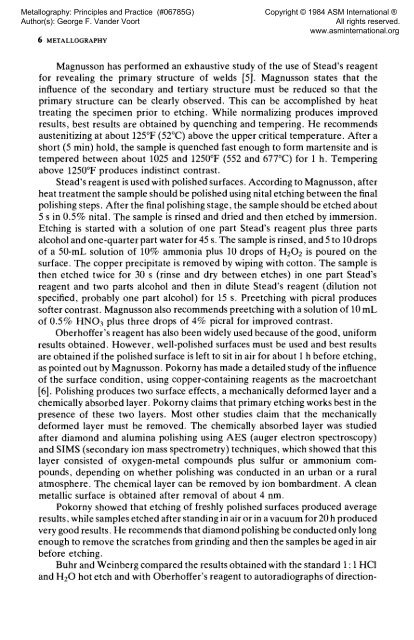Metallography: Principles and Practices - ASM International
Metallography: Principles and Practices - ASM International
Metallography: Principles and Practices - ASM International
Create successful ePaper yourself
Turn your PDF publications into a flip-book with our unique Google optimized e-Paper software.
<strong>Metallography</strong>: <strong>Principles</strong> <strong>and</strong> Practice (#06785G)<br />
Author(s): George F. V<strong>and</strong>er Voort<br />
6 METALLOGRAPHY<br />
Copyright © 1984 <strong>ASM</strong> <strong>International</strong> ®<br />
All rights reserved.<br />
www.asminternational.org<br />
Magnusson has performed an exhaustive study of the use of Stead's reagent<br />
for revealing the primary structure of welds [5]. Magnusson states that the<br />
influence of the secondary <strong>and</strong> tertiary structure must be reduced so that the<br />
primary structure can be clearly observed. This can be accomplished by heat<br />
treating the specimen prior to etching. While normalizing produces improved<br />
results, best results are obtained by quenching <strong>and</strong> tempering. He recommends<br />
austenitizing at about 125°F (52°C) above the upper critical temperature. After a<br />
short (5 min) hold, the sample is quenched fast enough to form martensite <strong>and</strong> is<br />
tempered between about 1025 <strong>and</strong> 1250°F (552 <strong>and</strong> 677°C) for 1 h. Tempering<br />
above 1250°F produces indistinct contrast.<br />
Stead's reagent is used with polished surfaces. According to Magnusson, after<br />
heat treatment the sample should be polished using nital etching between the final<br />
polishing steps. After the final polishing stage, the sample should be etched about<br />
5 s in 0.5% nital. The sample is rinsed <strong>and</strong> dried <strong>and</strong> then etched by immersion.<br />
Etching is started with a solution of one part Stead's reagent plus three parts<br />
alcohol <strong>and</strong> one-quarter part water for 45 s. The sample is rinsed, <strong>and</strong> 5 to 10 drops<br />
of a 50-mL solution of 10% ammonia plus 10 drops of H202 is poured on the<br />
surface. The copper precipitate is removed by wiping with cotton. The sample is<br />
then etched twice for 30 s (rinse <strong>and</strong> dry between etches) in one part Stead's<br />
reagent <strong>and</strong> two parts alcohol <strong>and</strong> then in dilute Stead's reagent (dilution not<br />
specified, probably one part alcohol) for 15 s. Preetching with picral produces<br />
softer contrast. Magnusson also recommends preetching with a solution of 10 mL<br />
of 0.5% HN03 plus three drops of 4% picral for improved contrast.<br />
Oberhoffer's reagent has also been widely used because of the good, uniform<br />
results obtained. However, well-polished surfaces must be used <strong>and</strong> best results<br />
are obtained if the polished surface is left to sit in air for about 1 h before etching,<br />
as pointed out by Magnusson. Pokorny has made a detailed study of the influence<br />
of the surface condition, using copper-containing reagents as the macroetchant<br />
[6]. Polishing produces two surface effects, a mechanically deformed layer <strong>and</strong> a<br />
chemically absorbed layer. Pokorny claims that primary etching works best in the<br />
presence of these two layers. Most other studies claim that the mechanically<br />
deformed layer must be removed. The chemically absorbed layer was studied<br />
after diamond <strong>and</strong> alumina polishing using AES (auger electron spectroscopy)<br />
<strong>and</strong> SIMS (secondary ion mass spectrometry) techniques, which showed that this<br />
layer consisted of oxygen-metal compounds plus sulfur or ammonium compounds,<br />
depending on whether polishing was conducted in an urban or a rural<br />
atmosphere. The chemical layer can be removed by ion bombardment. A clean<br />
metallic surface is obtained after removal of about 4 nm.<br />
Pokorny showed that etching of freshly polished surfaces produced average<br />
results, while samples etched after st<strong>and</strong>ing in air or in a vacuum for 20 h produced<br />
very good results. He recommends that diamond polishing be conducted only long<br />
enough to remove the scratches from grinding <strong>and</strong> then the samples be aged in air<br />
before etching.<br />
Buhr <strong>and</strong> Weinberg compared the results obtained with the st<strong>and</strong>ard 1:1HC1<br />
<strong>and</strong> H20 hot etch <strong>and</strong> with Oberhoffer's reagent to autoradiographs of direction-
















